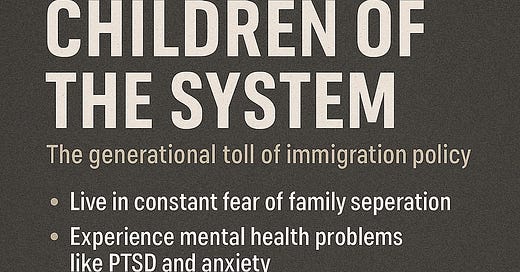CH 10 - Children of the System: The Generational Toll of Immigration Policy
From Criminal by Design: The Architecture of Harm in U.S. Immigration
Listen to the podcast
Return to the Criminal by Design: The Architecture of Harm in U.S. Immigration Hub
What happens to the children when their parents live in fear?
What does it do to a child’s nervous system when every knock on the door might mean goodbye? When school drop-offs come with whispered warnings and pickup becomes a question mark?
In the U.S. today, millions of children—many of them U.S. citizens—live under the shadow of immigration enforcement. They haven’t broken any laws. But they are punished all the same.
"They are citizens living like fugitives. Not because they did anything wrong—but because the system treats their parents like ghosts."
A Childhood Lived in Fear
According to the Center for Migration Studies, approximately 5.5 million children in the U.S. have at least one undocumented parent—and about 4 million of those children are U.S. citizens.
These kids:
Go to bed afraid they’ll wake up alone
Have anxiety attacks when their parents are late
Often experience food, housing, and emotional insecurity if a parent is detained
The trauma doesn’t wait for the moment of separation. It starts long before—inside the fear of what might happen.
"In households under threat of ICE raids, children exhibit elevated rates of PTSD, sleep disorders, and school disengagement." (Source: American Psychological Association, 2022)
Systems That Don’t See Them
Because their parents are undocumented, children often:
Avoid medical care due to fear of exposure
Lose eligibility for benefits they are legally entitled to
Miss school when a parent disappears
Live in mixed-status families forced to make impossible choices
Even when the children are U.S. citizens, they are treated as if their presence is conditional. They are invisible in courtrooms. Ignored in policy discussions. Disregarded in resource distribution.
"We treat these children like side effects—not citizens."
THX Breakdown — Intergenerational Harm
Utilities broken:
Security: No safe home, no guaranteed future
Closure: Threats that never resolve
Access: Barriers to education, healthcare, basic stability
Emotion Evoked: Chronic fear replaces joy
PERMAH erosion:
Positive Emotion: Rare and fragile
Relationships: Severed by policy or shattered by fear
Health: Long-term mental, emotional, and physical damage
Admiration Equation failure:
No Goodness in punishing children to deter others
No Awe in resilience twisted into survivalism
No Gratitude from a country these children were born into, pay taxes in, and call home
"The government demands their silence and obedience—but offers no stability in return."
Final Reflection and Challenge
Children should not have to earn their right to safety. And no child should be punished for who their parents are.
If we are the country we say we are, then our compassion cannot stop at paperwork.
"To protect children, we must protect the people they love."
Call to Action: Share this with someone who insists the system is working. Ask them to picture their own child—terrified to answer the door. Then ask: Is that what justice looks like?
NEXT - CH11: The Waiting Doesn’t End
Life Inside the Immigration Court Backlog
Limbo isn’t neutral. It’s trauma in slow motion.




